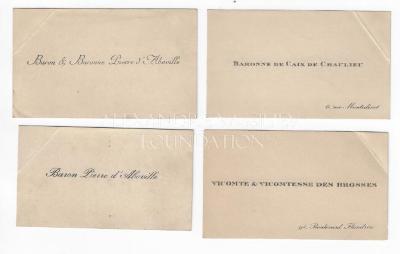Folded visit cards
Books & Magazines
Inventory number
2021.11.8.10ak.BM.OT.C1900.FRDescription
Set of 11 folded visiting cards of various French families, including aristocratic and religious, printed on cardboard in various sizes and printed between 1879 to 1935, some with a handwritten message. There is the visiting cards from Countess of SOUZA-DANTAN (aut 18.62 ?), Viscount and Viscountess of BROSSES, Baron Pierre d'ABOVILLE, Baron and Baroness Pierre d'ABOVILLE, Baroness of CAIX DE CHAULIEU, Baroness of ETCHEGOYEN (thousand regrets), General Baron BAILLOD, The Superior and the Sisters of the Hotel -Dieu de Beauvais, Daughters of Wisdom, Abbot E. COTTRAU, Gaëtan MOISANDIn the past, there was a protocol around the visiting card that developed a language. For example, a young girl could not have her own visit card (at the risk of being mistaken with a woman trading her body). She had to give the one of her parents where she had taken care to handwriten "Miss x" without adding her first name (unless if in the family, there was another girl using the same surname). Likewise, a visit card is never sent by post, except for the New Year wishes. In this case, it was customary to fold the card in the middle in order to indicate that the wishes were from all the family, otherwise it was necessary to put as many visit cards as there are family members. This custom of folding the card was a real language. When the fold was on the top left side of the card, that indicated that you had come by yourself; If you had come twice, the top right corner should be folded; Folded on the bottom left side, that you had come by yourself and left a gift; bottom right side, twice with gift. Around 1860, the bourgeoisie had taken the habit of indicating the number of their passage by folding either forwards or backwards, so the top right corner folded backwards indicated that you had come 4 times without success. This trend becoming complex and also showing the lack of education, the British choose to stop folding the corner of the cards and only folding across the width, on the left to indicate a courtesy visit and on the right for a condolence visit. At the beginning of the 20th century, the trend of folding the corners come back but only to indicate that the visits were for coutoisie or condolence, regardless the number of visits and accompanied or not by a gift.
Material
CarboardOrigin
circa 1900 FranceDimensions
Length : 10 cmHeight : 6 cm
